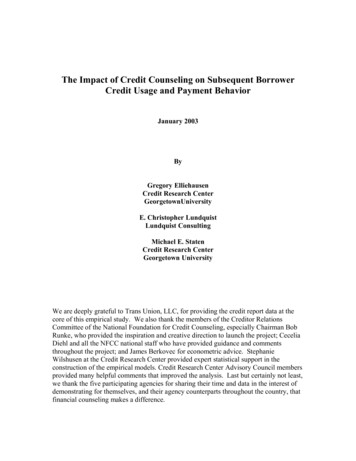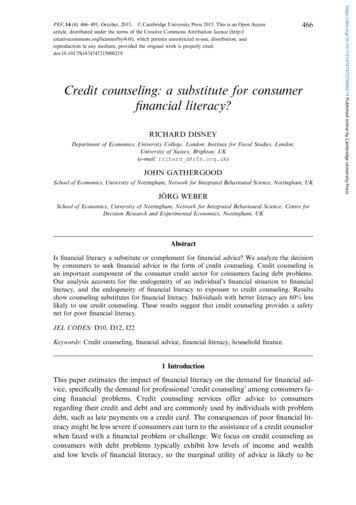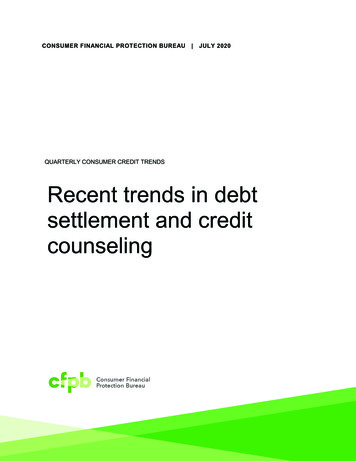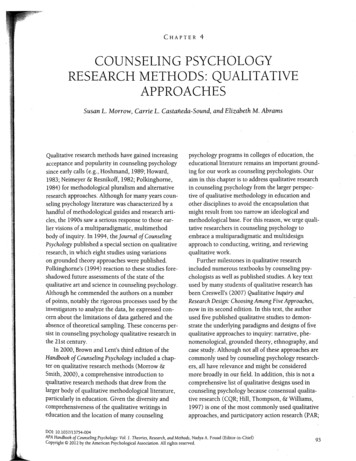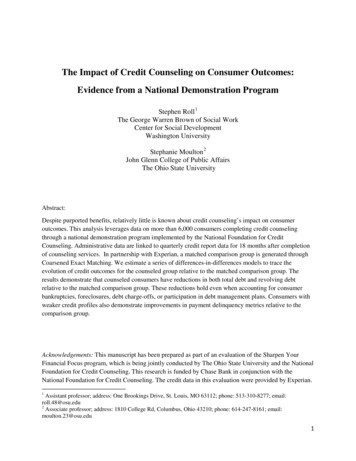
Transcription
The Impact of Credit Counseling on Consumer Outcomes:Evidence from a National Demonstration ProgramStephen Roll 1The George Warren Brown of Social WorkCenter for Social DevelopmentWashington UniversityStephanie Moulton 2John Glenn College of Public AffairsThe Ohio State UniversityAbstract:Despite purported benefits, relatively little is known about credit counseling’s impact on consumeroutcomes. This analysis leverages data on more than 6,000 consumers completing credit counselingthrough a national demonstration program implemented by the National Foundation for CreditCounseling. Administrative data are linked to quarterly credit report data for 18 months after completionof counseling services. In partnership with Experian, a matched comparison group is generated throughCoarsened Exact Matching. We estimate a series of differences-in-differences models to trace theevolution of credit outcomes for the counseled group relative to the matched comparison group. Theresults demonstrate that counseled consumers have reductions in both total debt and revolving debtrelative to the matched comparison group. These reductions hold even when accounting for consumerbankruptcies, foreclosures, debt charge-offs, or participation in debt management plans. Consumers withweaker credit profiles also demonstrate improvements in payment delinquency metrics relative to thecomparison group.Acknowledgements: This manuscript has been prepared as part of an evaluation of the Sharpen YourFinancial Focus program, which is being jointly conducted by The Ohio State University and the NationalFoundation for Credit Counseling. This research is funded by Chase Bank in conjunction with theNational Foundation for Credit Counseling. The credit data in this evaluation were provided by Experian.1Assistant professor; address: One Brookings Drive, St. Louis, MO 63112; phone: 513-310-8277; email:roll.48@osu.edu2Associate professor; address: 1810 College Rd, Columbus, Ohio 43210; phone: 614-247-8161; email:moulton.23@osu.edu1
INTRODUCTIONAs the U.S. economy begins to recover from the Great Recession, the use of consumer creditcontinues to increase. In the first quarter of 2016, the level of non-housing debt held by consumers in theU.S. approached 3.5 trillion dollars, up from just over 2 trillion dollars during the first quarter of 2004(Federal Reserve, 2016). Combined with lower levels of savings, higher debt levels can place consumersat risk of default and financial instability, particularly when unexpected financial shocks occur in futureperiods, such as the loss of a job or a medical crisis (Getter, 2003; Agarwal, Liu & Mielnick, 2003).Since the 1950’s, nonprofit credit counseling agencies in the U.S. have offered services toconsumers to help them negotiate and manage their debt obligations. In terms of overall reach, non-profitcredit counseling agencies have provided services to between 1.5 and two million consumers per year in2013 and 2014, and at the height of the recession these agencies provided services to nearly four millionconsumers in one year (NFCC, 2015; Keating, 2012). 3 To the extent that consumers are better able torepay and manage their debts as a result of the services received, these agencies can play a substantial rolein the functioning of consumer credit markets in the U.S., increasing the likelihood of repayment tocreditors and increasing the probability that consumers will be able to access to liquidity throughborrowing in future periods (Hunt, 2007).Despite purported benefits, relatively little is known about credit counseling’s impact onconsumer outcomes. To date, there has only been one systematic evaluation of credit counseling, whichfound modest improvements in the credit outcomes of high-risk consumers, while the results were moremixed for the general counseling population (Elliehausen, Lundquist, & Staten, 2007). That evaluation,however, only focuses on credit indicators at two points in time (the year a consumer received counselingand three years after they received counseling), which may ignore critical shorter-term changes inconsumer credit profiles. Further, the prior study focuses on clients who received counseling but who didnot participate in debt management plans. Debt management plans are often offered to clients as part of3These numbers have historically been much higher when including clients served at any credit counselingagencies, rather than just non-profit agencies. In 2003, for example, it was estimated that around nine million totalclients sought credit counseling in any agency (Loonin & Plunkett, 2003).2
credit counseling, and those who are unable or unwilling to participate in a debt management plan may besystematically different than those who choose to participate.This study addresses these gaps in the literature through an evaluation of a nationwide creditcounseling program called Sharpen Your Financial Focus, an initiative launched by the NationalFoundation for Credit Counseling (NFCC) in September of 2013. 4 The Sharpen initiative builds upon andenhances the standard counseling model implemented by NFCC affiliate agencies. As of March 2015,more than 40,000 consumers have received credit counseling services under the Sharpen initiative. Thisanalysis uses data on 6,094 consumers enrolling during the first quarter of the initiative through 13different affiliate agencies. In partnership with Experian, a matched comparison group is generatedthrough Coarsened Exact Matching (CEM).We estimate a series of differences-in-differences models to trace the evolution of creditoutcomes for the counseled group relative to the matched comparison group, from a pre-counselingbaseline period to six quarters (18 months) post-counseling. In addition to estimating the impact ofcounseling, we account for other time-varying credit interventions after counseling, includingbankruptcies, charge-offs and foreclosures. In an alternative specification, we trace outcomes separatelyfor counseled consumers enrolling in DMPs.The results indicate that consumers enter counseling at times of substantial financial distress, asindicated by higher rates of account delinquencies and declines in credit scores around the time ofcounseling. This is corroborated by administrative data tracking the reasons consumers give for enteringcounseling, in which they frequently indicate seeking counseling because of job loss or an unexpectedincrease in expenses. After the initial decline in credit outcomes at the time of counseling, consumers’credit scores and debt payment behaviors return to their pre-counseling levels about one year aftercounseling and begin to exceed their pre-counseling levels by the end of the evaluation period.4The NFCC is an umbrella membership organization representing more than 70 affiliate nonprofit financial andcredit counseling agencies nationwide.3
Relative to the comparison group, counseled consumers have significant reductions in their debtbalances after counseling. Specifically, counseled consumers have reductions in both total debt andrevolving debt relative to the matched comparison group. These reductions hold even when accountingfor consumer bankruptcies, foreclosures, debt charge-offs, or participation in a DMP. Consumersparticipating in agency-sponsored DMPs experience even greater reductions in debt balances relative tothe comparison group. Consumers with weaker credit profiles also demonstrate improvements in creditscores relative to the comparison group, though this improvement is not present across all consumers.PRIOR LITERATURE ON CREDIT COUNSELINGWhile the credit counseling industry has been around for a long period of time, relatively little isknown about the impact of credit counseling on consumer outcomes. Indeed, much of the existingliterature focuses less on credit counseling explicitly and instead focuses on targeted services that areoften offered by credit counseling agencies, such as pre- or post-purchase homeownership counseling(e.g. Agarwal, Amromin, Ben-David, Chomsisengphet, & Evanoff, 2009; 2010; Ding, Quercia, &Ratcliffe, 2008; Hartarska & Gonzalez-Vega, 2005; Quercia & Spader, 2008); matched savings programsor access to banking services combined with financial counseling (e.g. Clancy, Grinstein-Weiss &Schreiner, 2001; Wiedrich, Gons, Collins, & Drever, 2014); or financial education workshops for specificpopulations (e.g. Haynes-Bordas et al., 2008; ). These studies tend to find modest improvements amongcounseled households in areas such as reduced mortgage delinquency or improved knowledge aboutfinancial matters (Collins & O’Rourke, 2010).There are a few studies that focus on credit counseling explicitly. Kim, Garman, and Sorhaindo(2003) use pre- and post-counseling surveys and find that, while enrollment in a credit counselingprogram has no direct effects on financial behaviors, credit counseling participants do have a lowerpropensity to experience future financial stressor events like collection calls or foreclosures, and thatthose who remain active in DMPs have better self-assessed financial outcomes than those who do not.Bagwell (2000) uses a similar research design and finds that credit counseling participants report4
improved financial behaviors post-counseling relative to their pre-counseling behaviors, and also showimprovements in financial stress levels one year after counseling. Barron and Staten (2011) do not test theoverall impacts of credit counseling, but rather explore the relative effectiveness of “technology-assisted”counseling (counseling done over the phone or online) versus in-person counseling. Using the change incredit scores from pre-counseling to post-counseling, they find few differences between the modes ofdelivery on consumer outcomes. While these studies can provide descriptive insights, they lack acomparison group of non-counseled consumers against which to compare the outcomes of creditcounseling consumers—a necessary component for evaluating program impacts.One exception is a study on credit counseling conducted by Elliehausen, Lundquist, and Staten(2007). Using credit bureau data, Elliehausen, Lundquist, and Staten (2007) construct a comparisondataset of consumers who did not receive credit counseling, matched to be otherwise similar at baseline toa sample of consumers receiving credit counseling from NFCC member agencies in 1997. They employ atwo-stage least squares model to first predict selection into the credit counseling program, and then use aselection-corrected model to predict the impact of the receipt of counseling on an array of creditindicators. While they find that the impact on credit scores is relatively minimal once selection is takeninto account, they find positive impacts from credit counseling on debt levels, accounts held, and bankcard use. They find that positive effects tend to be stronger for those with the weakest credit profiles priorto counseling.Despite its strengths relative to other existing analyses, the Elliehausen, Lundquist, and Staten(2007) study does not account for debt reductions stemming from charge-offs or bankruptcies (rather thanconsumer or program-driven debt reductions), and does not include counseled consumers whoparticipated in DMPs. Further, the study of outcomes is limited to one point in time, three years after theinitial counseling session. This does not allow for the investigation of dynamic patterns in credit changesover time.5
CREDIT COUNSELING AND CREDIT OUTCOMESThere are several different mechanisms by which credit counseling may lead to improved creditoutcomes. While empirically isolating these mechanisms is not the central focus of our study, it isimportant to consider theoretically how credit counseling may impact specific consumer behaviors. Wefocus on four channels that are likely common across credit counseling programs: (1) increased awarenessof and attention to household finances; (2) increased financial knowledge and more informed financialdecisions; (3) increased accountability and support regarding financial decisions; and (4) counselingrelated structural changes that alter the composition or cost of debt.First, changes in consumer behavior from credit counseling may be driven in part by increasedawareness of their financial situation. As part of the counseling session, consumers complete a writtenbudget documenting their expenses and income. They also receive a copy of their credit report. In somecases, consumers may even receive a financial health score or rating through technology-assisted tools(like those included in the Sharpen initiative), designed to increase a consumer’s awareness of his or herpresent financial situation. Research has shown that people operating under stress or financial scarcity(presumably many of the consumers seeking credit counseling) often face high degrees of drain on theircognitive resources which limits their willpower and prevents them from thinking about longer-term goals(Baumeister, 2002; Mullainathan & Shafir, 2013), and recent research by Stango and Zinman (2014)demonstrates that even responding to survey questions about financial matters such as overdraft fees forchecking accounts can lead to improved consumer behaviors is in the near term, such as a reduction inbeing charged overdraft fees. Thus, by participating in the counseling session, consumers may pay moreattention to their use and management of their income and debt the period following the session, whichmay lead to lower overall levels of consumer debt relative to non-counseled individuals.Second, credit counseling may impact consumer behavior through increased financial knowledge.For example, consumers may be aware of the interest rate on their credit cards, but may not fullyunderstand how interest compounds over time and affects the amount they will owe. Once they learn thisinformation, they may be more likely to pay off their balances each month rather than incurring interest or6
late fees. This type of information may be transmitted during the counseling session informally, through adiscussion with the counselor about the consumers’ obligations, or it may occur through workbooks,brochures or educational classes or workshops that are offered alongside credit counseling programs.There is some evidence that low levels of financial knowledge are associated with suboptimalfinancial behaviors. Lusardi and Mitchell (2014) find that only 30 percent of the US population cancorrectly answer three basic questions on personal finance. They also demonstrate that sub-optimalborrowing behaviors such as late bill payments, going over credit limits, or paying minimum amounts oncredit card debt are associated with lower levels of financial literacy. While financial literacy is associatedwith consumer behaviors, there is mixed evidence regarding the ability of financial education to changeconsumer behaviors (Miller et al. 2014; Fernandes, Lynch, & Netemeyer 2014), although there is someevidence of stronger impact when financial education is provided “just in time,” alongside importantfinancial decisions (Fernandes, Lynch, & Netemeyer 2014). To the extent that consumers entercounseling due to an immediate or pending change in their financial circumstances, they may be morelikely to use the information from counseling to make better financial decisions post-counseling.Third, credit counseling may enhance consumers’ sense of accountability and support with regardto their financial decisions. For example, counseled consumers may commit to reduce expenses as part ofan action plan developed during the counseling session. By making this written commitment, theconsumer may feel accountable to the counselor if they do not adhere to their action plans, and this senseof accountability may lead to better adherence to the plan (Lerner & Tetlock, 1999). This is particularlytrue to the extent that there is any ongoing contact between the counselor and consumer after the initialsession. Some credit counseling agencies follow-up with consumers at set intervals post counseling tocheck on their progress towards their financial goals (Wang, 2010)—a form of financial coaching.Financial coaching has grown out of the more general field of “coaching” and has a variety of attributesincluding monitoring and evaluating progress and providing feedback, being collaborative and clientdriven in nature, and focusing on the development of a client’s strengths (Collins & O’Rourke, 2012).There is an evolving body of literature that suggests that financial coaching can lead to improved7
consumer behaviors (Collins & O’Rourke, 2012; Collins, 2013; Moulton et al., 2015; Theodos et al.,2015). The relationships counselors form with their clients, including any ongoing contact to monitorprogress, may lead to further positive changes in consumer financial behaviors.Finally, credit counseling may impact consumer behavior through structural changes to debt thatoccur as a result of a consumer’s participation in counseling. For example, by participating in counseling,consumers may be less (or more) likely to file for bankruptcy, thus affecting their overall indebtedness.Or, for homeowners, they may be more likely to be referred to a mortgage modification program and thusprevent foreclosure. Most notably, credit counseling agencies typically offer consumers the option ofparticipating in a debt management plan (DMP). Through a DMP, counseling agencies negotiate withcreditors to lower interest rates or waive fees for consumers, making an individual’s overall debt situationmore sustainable and increasing the likelihood of successful debt repayment (Bagwell, 2000). Byconsolidating multiple debt streams into one, DMPs eliminate the need for consumers to manage multiplepayments; they no longer have to track multiple due dates and differing payment requirements for eachdebt stream. This reduction in complexity may enhance the propensity for consumers to successfully payoff their debts, though the existing research on this potential is mixed (Amar, Ariely, Ayal, Cryder, &Rick, 2011; Gal & McShane, 2012).DATA AND METHODSSample ConstructionCounseled Sample ConstructionTo analyze the relationship between credit counseling and consumer outcomes, we use data fromthe NFCC’s Sharpen Your Financial Focus credit counseling program. The NFCC launched the Sharpeninitiative in September of 2013, and through March of 2015, 43,072 consumers have received servicesthrough the initiative. Prior studies of credit counseling tend to be limited to evaluating the servicesprovided by a single agency or small set of agencies due to the heterogeneity of services offered by8
different agencies (e.g. Bagwell, 2000; Kim et al., 2003; Elliehausen, Lundquist, & Staten, 2007). Bycontrast, the Sharpen initiative has the benefit of standardizing the counseling services offered to a largenumber of consumers across multiple affiliate agencies.Specifically, the services provided by agencies under the Sharpen initiative represent recentindustry innovations and best practices, including an online financial stress test (named“MyMoneyCheckUp”) aimed at increasing consumers’ awareness of their own financial activities andoverall financial health; a financial review with an NFCC-certified financial professional to helpconsumers establish goals and action plans; and the opportunity to receive targeted education oradditional information (referred to as a “deep dive”) on a financial area of interest or concern to theconsumer. 5 As appropriate to their financial circumstances, consumers receiving services under theSharpen program may also be referred to participate in an agency-sponsored DMP. In this way, theSharpen initiative incorporates the three core elements of standard credit counseling: credit and budgetcounseling, financial education, and debt management (Loonin & Plunkett 2003; Samuelson & Stiller2012).The sample for this study is limited to consumers receiving services from 13 of the 70 memberagencies, for whom credit attribute data could be linked to administrative counseling data.6 ThroughMarch of 2015, the 13 member agencies served a combined total of 18,829 consumers, comprising 44percent of the total 43,072 consumers enrolled in Sharpen. We further limit the sample to 10,925consumers enrolling during the first quarter of the program, from September 1, 2013 to November 30,2013. This allows for the collection of eighteen months of post-counseling data for all households in thesample. Finally, the analysis sample is limited to those consumers with complete credit data (n 8,963),for whom a match could be generated during the baseline period, resulting in 6,094 counseled consumers.5More details on the NFCC’s Sharpen Your Financial Focus initiative are available online, at:https://sharpen.nfcc.org/6Thirteen agencies were selected based on successful implementation of the Sharpen initiative, as well as theircapacity to submit additional data including documented permission from clients to obtain credit data. Only thoseagencies who had obtained consent from consumers to use their data for research purposes were included in theevaluation.9
Appendix A provides a visual diagram of the sample construction for this analysis. Appendix B providesa comparison of the administrative characteristics for the sample of consumers counseled by the memberagencies included in this analysis, relative to the full population of Sharpen participants. 7Data on counseled consumers are generated from two sources. Administrative data is compiled bycounseling agencies, measuring consumer demographic and financial data as well as reasons for seekingcounseling and the outcomes of the counseling session. 8 Longitudinal credit attribute data is provided byExperian, which includes a variety of credit indicators including credit score, revolving and installmentbalances, debt payment delinquencies, and the number of charge-offs, bankruptcies, and foreclosures onan individual’s credit record. The administrative data is cross-sectional and recorded at the time aconsumer enrolls in counseling (baseline), while the credit data is provided at quarterly intervals. For eachconsumer included in the analysis sample, we have credit attribute data for the quarter prior to baselineand six quarters post-baseline.On average, consumers in this credit counseling program tend to be female, white, unmarried(either single, widowed, or divorced), and middle aged. They also tend to be well-educated with aroundtwo-thirds reporting some education beyond high school, and come from relatively small households. Interms of financial characteristics, the average counseled consumer has monthly household income ofabout 3,000, and savings of 500, with the median counseled consumer reporting no savings. Theadministrative counseling data provides some evidence of a shock driving consumers to seek counseling.The majority of consumers (almost two-thirds) reported seeking counseling because of reduced income,while another 30 percent reported facing increased expenses. Tables 1 and 2 provide summary statisticsfor counseled consumers, including self-reported motivations for seeking counseling.7All metrics except consumers’ average monthly income are significantly different between the groups; however, thedifferences are not substantively large. In terms of the demographic characteristics, consumers in both agencygroups are roughly similar, though consumers in non-participating agencies are more likely to have a high schooldiploma or four year college degree. There are some notable differences in the financial characteristics betweenagencies. While the average monthly income and monthly housing expenses are relatively similar, consumers inparticipating agencies had fewer debt-related expenses, more tangible assets, less in liquid savings, and moreliabilities.8Counseling outcomes include whether or not the consumer was referred to a DMP, whether or not the consumercompleted the online financial health check-up, and whether or not the consumer completed additional financialeducation.10
[Insert Tables 1 & 2 Here]Matched Comparison Sample ConstructionThe comparison group was drawn using Experian’s credit database which contains creditinformation for all households in the United States. From this database, a five percent random sample ofU.S. individuals was generated and comparison group members were selected based on their similarity tocounseled individuals across the matching covariates referenced above. Specifically, comparison groupmembers were identified using Coarsened Exact Matching (CEM), a method of data processing whichuses Monotonic Imbalance Bounding to match treated and untreated observations and allows for causalanalyses using a variety of estimation approaches. This technique is similar to more traditional propensityscore matching, but has been found to improve the balance, error, and efficiency of traditional propensityscore matching methods (Iacus, King, & Porro, 2012).In CEM, data to be used for matching are first “coarsened” into categories by variable, and thenobservations in the treatment and comparison groups are assigned into strata that correspond to the exactcombination of categories for the matching variables. Weights are then assigned by stratum to account formultiple treatment and comparison observations within a given stratum, and for differences in the overallsize of the treatment and comparison groups. Observations from the treatment group that are assigned to astratum without an equivalent match in the comparison group are given a weight of “0”, and are excludedfrom the analysis.Credit indicators used to construct the match include revolving debt levels, 9 bankruptcy history,the age of the oldest trade, mortgage debt levels, the presence of any payment delinquencies 60 days orgreater in the past 12 months, the presence of any mortgage payment delinquencies 90 days or greater inthe past 24 months, the balance-to-credit ratio, the credit score, and the state of residence.10 These9Specifically, individuals in the comparison and counseled groups were matched on open revolving debt, whichdoes not include balances on accounts voluntarily closed by consumers. This debt measure is a very good proxy fortotal revolving debt, and as can be seen from Table 3, the comparison and counseled groups are still extremely wellmatched on total revolving debt.10Matching was also attempted on the first three digits of the zip code rather than the state of residence, but thisresulted in too few matches so the geographical scope was broadened to the state level.11
indicators were selected for the matching process because they represent a diverse array of elementswhich may impact a person’s short- and long-term credit outcomes. A history of delinquent paymentsmay indicate a higher propensity have future delinquencies; debt levels may impact the rate at which aperson pays down their debts (this may also be influenced by the type of debt); bankruptcy impacts aperson’s access to future credit; the age of accounts serves as a proxy for a person’s experience withcredit and plausibly captures certain life cycle factors that can affect debt levels, savings, income, etc.;and the state of residence serves to capture specific macroeconomic or institutional factors which may berelevant, such as the employment conditions of a state.Out of 8,963 counseled consumers, matches were found for 6,297, or 70 percent. 11 Of thesematched consumers, 137 observations were dropped from the comparison group because they hadreceived credit counseling and were in the counseling sample. After excluding any observations with dataissues, 6,094 counseled consumers remained matched with 6,005 non-counseled individuals.In order to assess the accuracy of the matching process, differences in the means of eachmatching variable between the counseled and comparison groups at baseline were calculated, andstandardized differences are reported. Ideally, the resulting sample will be completely balanced, with littleto no difference in baseline characteristics between groups (standardized differences below 0.05). 12 Asreported in Table 3, the standardized differences for the matching variables range between 0.01 and 0.04,indicating a well-balanced sample. At baseline, consumers from both the counseled group and thematched comparison group have credit scores just under 600, open revolving debt levels of around 10,000, installment debt levels around 21,000, mortgage debt around 45,000, around 0.3 bankruptcies11Almost by definition, consumers for whom there was no match likely have more unique credit circumstances, soby excluding these consumers for lack of a match it is also possible we are failing to capture credit counseling’simpacts on these relatively idiosyncratic clients. A comparison of the characteristics and credit outcomes betweenmatched and unmatched consumers (available from the authors upon request) shows that counseled consumers whowere unmatched are relatively distressed compared to the matched counseled consumers, with lower credit scoresand higher debt levels; however trends in credit scores and debt levels for the counseled consumers in theunmatched group are similar to those of the matched group.12Standardized differences are a function of the differences in the variable mean between the groups divided by thetotal standard deviation of the combined sample (Austin, 2009). Per the Institute of Education Sciences (2014) bestpractices, any variable with a standardized difference below 0.05 between groups is considered to be well-balanced.12
on average, an oldest account around 15 years old, 0.6 payments 60 days delinquent or more in the lastyear, 0.1 delinquent mortgage payments in the last two years, and a balance to credit ratio of 0.5.Additionally, several variables are included in Table 3 that were not matching variables but aredependent variables
credit counseling agencies have provided services to between 1.5 and two million consumers per year in 2013 and 2014, and at the height of the recession these agencies provided services to nearly four million consumers in one 3year (NFCC, 2015; Keating , 2012).




